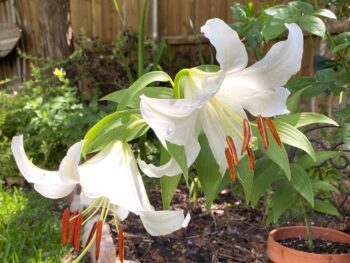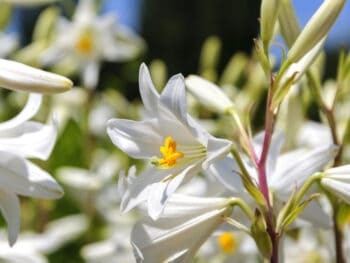What gardener would not be delighted by a holiday celebrated with a plant list?! The final appointed celebration decreed by the Lord in Leviticus 23 (also Exodus 23 and Deuteronomy 16) is the Feast of Tabernacles (also called Feast of Ingathering or Booths, or Sukkot in Hebrew), taking place this week, September 24th to September 30th. It comes with a list of branches and specific direction to use them in celebrating and creating temporary shelters.
That is, a booth, tent, lean-to, or sukkah in Hebrew, serving as a holy remembrance of the Israelites’ journey—delivered from slavery in Egypt to provisional dwelling in the Sinai wilderness until they reached their promised, permanent homeland. The Lord was faithfully present with his people every shade of the way…
Because of your great compassion you did not abandon them in the wilderness. By day the pillar of cloud did not fail to guide them on their path, nor the pillar of fire by night to shine on the way they were to take. You gave your good Spirit to instruct them.
Nehemiah 9:19-20 NIV
..and behold the joy found in His presence:
…you will fill me with joy in your presence
Psalm 16:11 NIV
No wonder this holiday festival is a dramatic display and heritage of rejoicing!
Then all the people went away to eat and drink, to send portions of food and to celebrate with great joy
Nehemiah 8:12 NIV
Celebration Branches
Whether you are reading about this celebration from Leviticus or Nehemiah, in whichever Bible translation you favor, you will see fruitfulness and greenery raised and presented in joyful gesture honoring the Lord:
On the first day you are to take branches from luxuriant trees—from palms, willows and other leafy trees—and rejoice before the Lord your God for seven days.
Leviticus 23:40 NIV
On the first day you are to take choice fruit, palm fronds, thick branches and river-willows, and celebrate in the presence of Adonai your God for seven days.
Leviticus 23:40 CJB
And ye shall take you on the first day the boughs of goodly trees, branches of palm trees, and the boughs of thick trees, and willows of the brook; and ye shall rejoice before the Lord your God seven days.
Leviticus 23:40 KJV
“Go out into the hill country and bring back branches from olive and wild olive trees, and from myrtles, palms and shade trees, to make temporary shelters”—as it is written.
Nehemiah 8:15 NIV
“Go out to the mountains, and collect branches of olives, wild olives, myrtles, palms, and other leafy trees to make sukkot, as prescribed.”
Nehemiah 8:15 CJB
“Go out to the hills, and bring olive branches and wild olive branches, myrtle branches, palm branches and branches of other leafy trees, to make booths, as it is written.”
Nehemiah 8:15 NASB
Care to plant a remembrance of rejoicing in your yard? I do! I want to think on the joy of the Lord whenever I look outside, and let beauty and loveliness be His shelter to me.
Date Palm Dilemma
As gardeners, we have variety to choose from in the listed botanicals for creating a planting that reflects God’s joy and festivity found in this Feast—myrtles, willows, wild olives [oleaster or elaeagnus], poplars, trees leafy and thick, which some interpret as chaste tree—yet one plant stands certain: the palm, consistent in all lists and translations. Yet how to represent the splendid palm when your garden space is small, or colder than what palm’s hardiness prefers?
I was delighted to discover ‘Soft Caress’ Mahonia, a small, handsome shrub available in the Southern Living Plants Collection, to stand in my garden in place of palm.
Enter ‘Soft Caress’ Mahonia
Let me be clear, mahonia is Not a Bible Plant. I like to remind myself, “NBP;” it is not native to the Mediterranean region and bears no relation to Arecaceae, the botanical family of palms. However, the likeness of ‘Soft Caress’ leaves as miniature palm fronds; graceful, diminutive, dentate leaflets arranged along a central rib, makes this shrub a meaningful substitute, especially for a gardener with an eye to floral design.


From Hosanna! to Hoshanah Rabbah, may this lovely mahonia serve beautifully as your remembrance for rejoicing in the Lord in your garden.
Lord, save us! Lord, grant us success!
Blessed is he who comes in the name of the Lord.
From the house of the Lord we bless you.
The Lord is God, and he has made his light shine on us.
With boughs in hand, join in the festal procession up to the horns of the altar.
You are my God, and I will praise you; you are my God, and I will exalt you.
Give thanks to the Lord, for he is good; his love endures forever.
Psalm 118:25-29 NIV
Visit me in my garden Live earlier this week – getting ready to plant this stand of ‘Soft Caress’ Mahonia
Visit Southern Living Plants for more information on ‘Soft Caress’ Mahonia
Find more on the Feast of Tabernacles in Celebrating the Harvest, the Garden Work section of God’s Word for Gardeners Bible, pages a-36 & a-37 and visit Judaism 101 – Sukkot
Discover more about date palm in the Plant Guide, gardenndelight.wpengine.com/plant-guide/date-palm/
Many thanks my dear friends at Plant Development Services, Inc. for supplying the shrubs featured in this blog and so much more support to GWA: The Association of Garden Communicators
Photo Credits: ©2018 Shelley S. Cramm

















